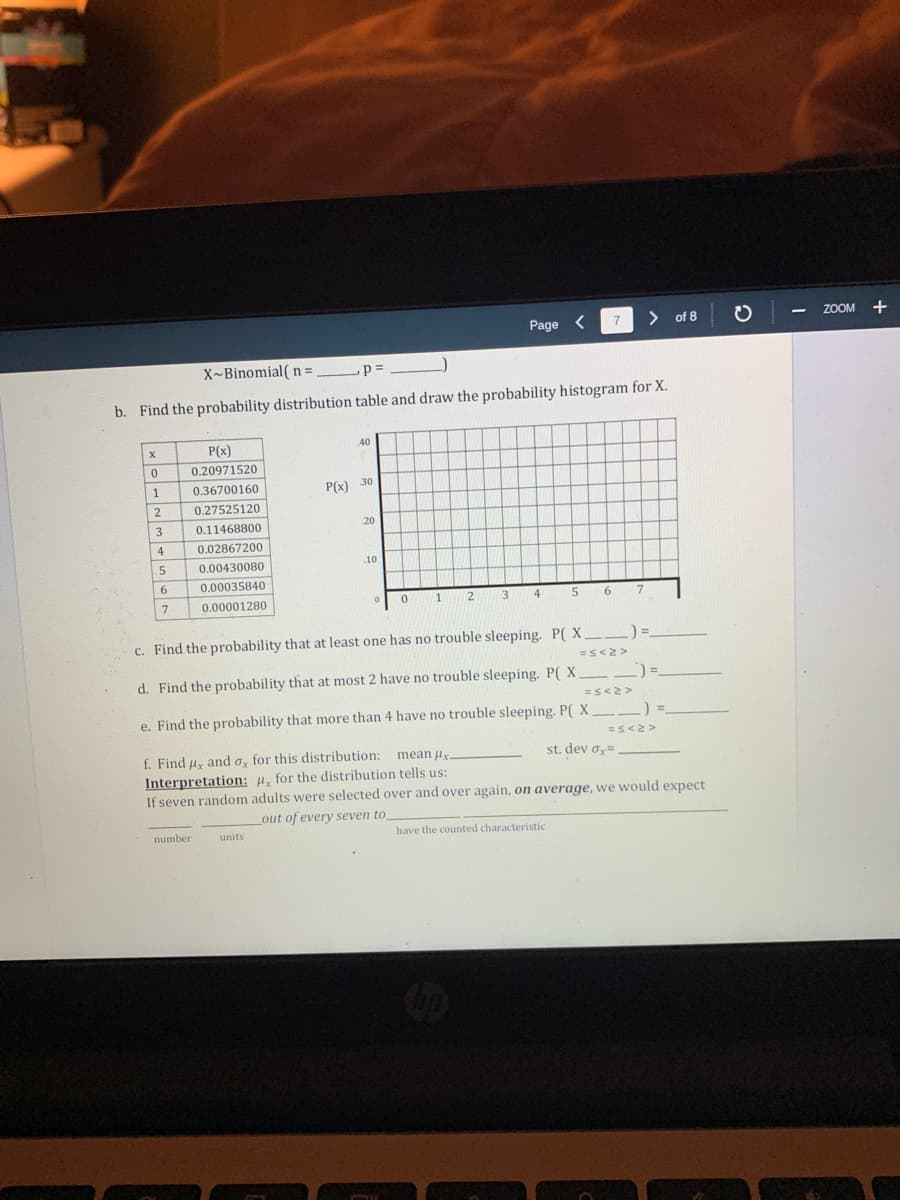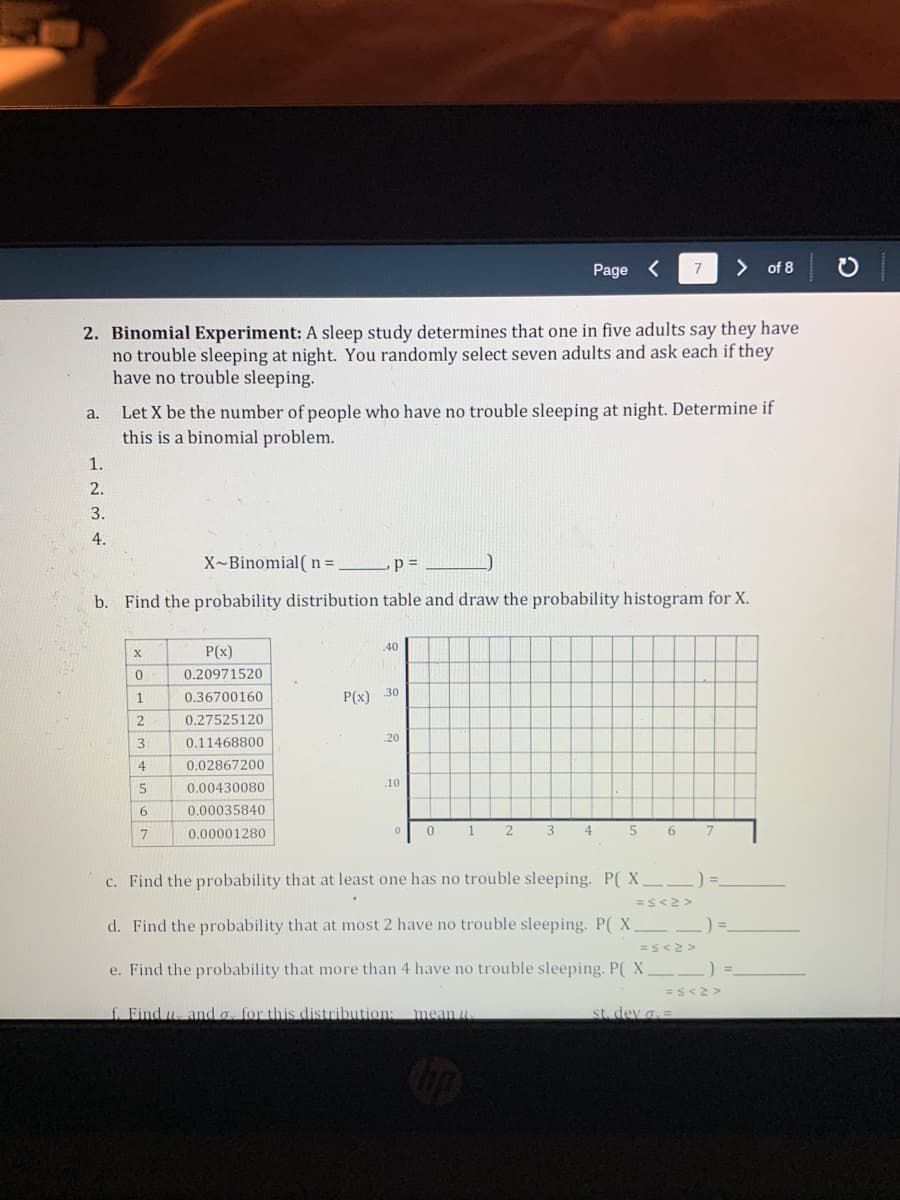2. Binomial Experiment: A sleep study determines that one in five adults say they have no trouble sleeping at night. You randomly select seven adults and ask each if they have no trouble sleeping. Let X be the number of people who have no trouble sleeping at night. Determine if this is a binomial problem. a. 1. 2. 3. X~Binomial( n= p = b. Find the probability distribution table and draw the probability histogram for X. 40 P(x) 0. 0.20971520 0.36700160 P(x) 30 1 0.27525120 20 3. 0.11468800 4 0.02867200 .10 0.00430080 6. 0.00035840 0.00001280 0 1 2 3 4 5 6 7 7. c. Find the probability that at least one has no trouble sleeping. P( X )= d. Find the probability that at most 2 have no trouble sleeping. P( X ): e. Find the probability that more than 4 have no trouble sleeping. P(X _) ES<2> f. Find u and a for this distribution mean u st. dev a=
2. Binomial Experiment: A sleep study determines that one in five adults say they have no trouble sleeping at night. You randomly select seven adults and ask each if they have no trouble sleeping. Let X be the number of people who have no trouble sleeping at night. Determine if this is a binomial problem. a. 1. 2. 3. X~Binomial( n= p = b. Find the probability distribution table and draw the probability histogram for X. 40 P(x) 0. 0.20971520 0.36700160 P(x) 30 1 0.27525120 20 3. 0.11468800 4 0.02867200 .10 0.00430080 6. 0.00035840 0.00001280 0 1 2 3 4 5 6 7 7. c. Find the probability that at least one has no trouble sleeping. P( X )= d. Find the probability that at most 2 have no trouble sleeping. P( X ): e. Find the probability that more than 4 have no trouble sleeping. P(X _) ES<2> f. Find u and a for this distribution mean u st. dev a=
Elements Of Modern Algebra
8th Edition
ISBN:9781285463230
Author:Gilbert, Linda, Jimmie
Publisher:Gilbert, Linda, Jimmie
Chapter2: The Integers
Section2.7: Introduction To Coding Theory (optional)
Problem 7E
Related questions
Concept explainers
Contingency Table
A contingency table can be defined as the visual representation of the relationship between two or more categorical variables that can be evaluated and registered. It is a categorical version of the scatterplot, which is used to investigate the linear relationship between two variables. A contingency table is indeed a type of frequency distribution table that displays two variables at the same time.
Binomial Distribution
Binomial is an algebraic expression of the sum or the difference of two terms. Before knowing about binomial distribution, we must know about the binomial theorem.
Topic Video
Question

Transcribed Image Text:Page
7
> of 8
ZOOM +
X~Binomial( n=
b. Find the probability distribution table and draw the probability histogram for X.
40
P(x)
0.20971520
0.36700160
P(x) 30
0.27525120
3.
0.11468800
20
4
0.02867200
0.00430080
.10
6.
0.00035840
7
0.00001280
3
4
6.
c. Find the probability that at least one has no trouble sleeping. P( X
_) =
d. Find the probability that at most 2 have no trouble sleeping. P( X.
e. Find the probability that more than 4 have no trouble sleeping. P( X
f. Find uy and o, for this distribution:
Interpretation: 4, for the distribution tells us:
If seven random adults were selected over and over again, on average, we would expect
mean u
st. dev o=
out of every seven to
number
units
have the counted characteristic

Transcribed Image Text:Page <
> of 8
7
2. Binomial Experiment: A sleep study determines that one in five adults say they have
no trouble sleeping at night. You randomly select seven adults and ask each if they
have no trouble sleeping.
Let X be the number of people who have no trouble sleeping at night. Determine if
this is a binomial problem.
a.
1.
2.
3.
4.
X~Binomial ( n3=
b. Find the probability distribution table and draw the probability histogram for X.
.40
P(x)
0.20971520
30
1
0.36700160
P(x)
0.27525120
20
0.11468800
4
0.02867200
.10
0.00430080
6.
0.00035840
0.00001280
1
3.
4
6.
c. Find the probability that at least one has no trouble sleeping. P( X.
_)=.
=s<2>
d. Find the probability that at most 2 have no trouble sleeping. P( X
=s<2>
e. Find the probability that more than 4 have no trouble sleeping. P( X.
-) =.
f. Find u and a for this distribution:
mean u
st. dev a=
Expert Solution
This question has been solved!
Explore an expertly crafted, step-by-step solution for a thorough understanding of key concepts.
This is a popular solution!
Trending now
This is a popular solution!
Step by step
Solved in 4 steps with 4 images

Knowledge Booster
Learn more about
Need a deep-dive on the concept behind this application? Look no further. Learn more about this topic, statistics and related others by exploring similar questions and additional content below.Recommended textbooks for you

Elements Of Modern Algebra
Algebra
ISBN:
9781285463230
Author:
Gilbert, Linda, Jimmie
Publisher:
Cengage Learning,

Algebra & Trigonometry with Analytic Geometry
Algebra
ISBN:
9781133382119
Author:
Swokowski
Publisher:
Cengage

College Algebra
Algebra
ISBN:
9781305115545
Author:
James Stewart, Lothar Redlin, Saleem Watson
Publisher:
Cengage Learning

Elements Of Modern Algebra
Algebra
ISBN:
9781285463230
Author:
Gilbert, Linda, Jimmie
Publisher:
Cengage Learning,

Algebra & Trigonometry with Analytic Geometry
Algebra
ISBN:
9781133382119
Author:
Swokowski
Publisher:
Cengage

College Algebra
Algebra
ISBN:
9781305115545
Author:
James Stewart, Lothar Redlin, Saleem Watson
Publisher:
Cengage Learning

Holt Mcdougal Larson Pre-algebra: Student Edition…
Algebra
ISBN:
9780547587776
Author:
HOLT MCDOUGAL
Publisher:
HOLT MCDOUGAL